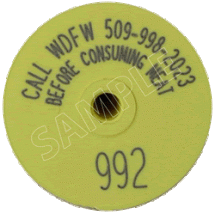
If you harvest a game animal bearing a round yellow tag, it means that at some point in its life the animal was treated with a drug. Drug residues may remain in the animal’s system for several weeks after it was treated, depending on the particular drug and the species of animal. These drug residues may be harmful to humans if they are still present when the meat of the animal is consumed. The time from when the animal received the drug until the drug residues are no longer in the animal’s system is called the “withdrawal period”.
How can I tell if the drug withdrawal period has passed?
By entering the unique number found on the round yellow ear tag into the space below, you can retrieve information to help you determine whether it is safe to consume your harvested game animal. This information is based on federal Food and Drug Administration guidelines on time required for the animal to have completely metabolized the drug.
Enter the tag number found on the round yellow ear tag in the field provided, then click Check Tag.
Important: If the end of the withdrawal period is in the future, and the animal is already dead, freezing it until that date will not render it safe to eat. The drugs can only be metabolized out of an animal’s tissues if the animal is alive.
Why do game animals receive drugs?
WDFW uses drugs to capture animals for a variety of reasons. The animal may need to be relocated, it may be part of a research study, or it may have been injured and required assistance. In addition, when animals are captured, they sometimes receive injections of antibiotics or other medications.
What about other tags?
Sometimes an animal will have a larger (usually rectangular) tag in its ear. These tags are numbered, can be any color, and may be imprinted with a request to contact WDFW if the animal is harvested. If the animal was drugged at some point, around yellow ear tag with the message: “Call WDFW Before Consuming Meat,” may have been used as the “stud” on the back of the ear to attach the larger numbered ear tag. Because of this, it is important to check both sides of the ear. If no yellow round tag is present, then the animal either did not receive any drugs, or did not receive drugs at a time when drug residues might remain at the time of legal harvest.
What types of animals are tagged?
WDFW drugs and tags many species of animals. These may include: bear, deer, moose, elk, cougar, wolves, coyotes, wolverines, badgers, raccoons, foxes, fish and birds. The animals that are of most concern relative to the drugs used are deer, elk, moose, bear, and cougar.
Who is drugging and tagging these animals?
WDFW veterinarians, wildlife biologists, and wildlife enforcement officers are all trained and certified to use these drugs on wildlife.